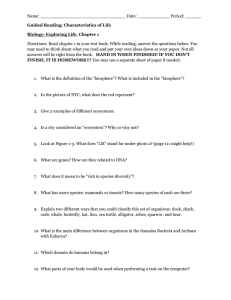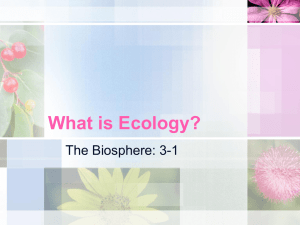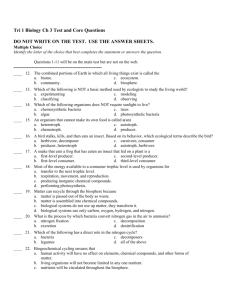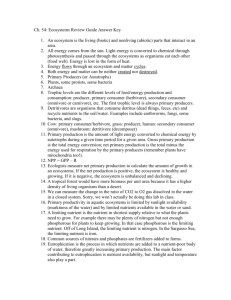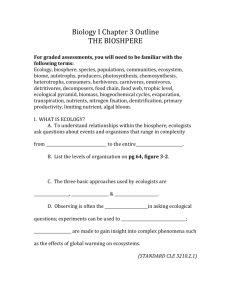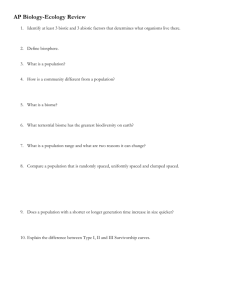File
advertisement
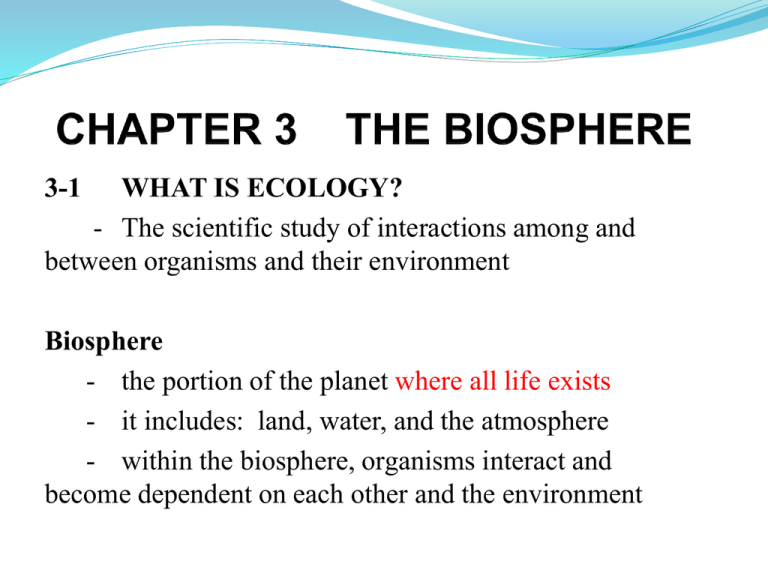
3-1 WHAT IS ECOLOGY? - The scientific study of interactions among and between organisms and their environment Biosphere - the portion of the planet where all life exists - it includes: land, water, and the atmosphere - within the biosphere, organisms interact and become dependent on each other and the environment Ecological Levels of Organization - range from the study of an individual organism to populations, communities, ecosystems, biomes and finally the biosphere species - groups of organisms similar enough to breed and produce fertile offspring populations - individuals that belong to the same species and live in the same area communities - groups of different populations living in a particular region ecosystem - a collection of all the organisms of a particular place along with their non-living (physical) environment biome - a group of ecosystems with the same climate and similar dominant communities all biomes are found within the biosphere Ecological Levels of Organization 3-2 Energy Flow through the Ecosystem A. Producers - sunlight is the main energy source of life used by plants, algae, and some bacteria and they are called autotrophs or producers - some organisms like certain types of bacteria obtain energy from other sources such as energy stored in inorganic chemical compounds such as hydrogen sulfide (chemosynthesis) Ex. Mineral water from hot springs or underwater sea vents - producers are necessary to the flow of energy through the biosphere Energy from the sun - energy is obtained through photosynthesis - light energy powers chemical reactions to change carbon dioxide and water into oxygen and carbohydrates such as sugar and starch - photosynthesis adds oxygen and removes carbon dioxide from the atmosphere and the autotrophs provide the oxygen that we need The main autotrophs are: 1. plants – land 2. algae – upper layers of ocean and freshwater ecosystems (lakes, rivers, etc.) 3. photosynthetic bacteria – found in tidal flats and salt marshes B. Consumers - organisms who cannot get energy directly from the environment - includes animals, fungi, and some bacteria - acquire energy and food from other organisms and are called heterotrophs or consumers Examples: 1. herbivores – eat only plants; cows, deer 2. carnivores – eat animals; snakes, dogs, owls 3. omnivores – eat plants and animals; humans, bears, crows 4. detrivores – eat decaying, dead matter (detritus); earthworms, snails, crabs, mites 5. decomposers – break down organic matter; bacteria and fungi C. Feeding Relationships - Energy flows through the ecosystem in one direction Sun and inorganic compoundsautotrophsheterotrophs (producers) (consumers) 1. Food chain - a series of steps in which organisms transfer energy by eating and being eaten 2. Food Webs - show more complex feeding relationships among organisms in an ecosystem - they link all the food chains in an ecosystem Fig. 3-8 3. Trophic Levels - represent each step in a food chain - producers are on the first trophic level - consumers are on the second, third, or higher trophic levels - each consumer depends on the level below it for energy Trophic Levels D. Ecological Pyramids - diagrams showing amounts of energy or matter contained in each trophic level in a food chain or web 3 Types of pyramids: 1. Energy Pyramid - shows the amount of energy available at each trophic level - organisms use only 10% of this for life processes; the rest is lost as heat - the more levels that exist, the less energy that remains from the original amount Energy Pyramid 2. Biomass Pyramid - shows the amount of living organism matter in each trophic level with greatest biomass at the base - represents the amount of potential food available at each level 3. Pyramid of Numbers - shows the number of individual organisms at each trophic level 3-3 Cycles of Matter A. Recycling in the biosphere - matter is recycled differently than energy - it is recycled within and between ecosystems - elements, compounds, and other forms of matter are passed from one organism to another and from one biosphere to another through biogeochemical cycles • connect biological, geological, and chemical parts of the biosphere Water Cycle - water moves between the ocean, atmosphere, and land - involves evaporation and transpiration Nutrient Cycles - like water, nutrients are passed between organisms and the environment through biogeochemical cycles - nutrients are chemical substances that an organism requires to live; the body’s “building blocks” Carbon Cycle - carbon is the key ingredient in all living organisms - it is found in the oceans, air, and certain rocks Four processes are involved in the carbon cycle: 1. - Biological Processes photosynthesis (removes carbon dioxide) respiration (adds carbon dioxide) decomposition of plants and animals 2. Geochemical Processes - release of carbon dioxide gas into the atmosphere by volcanoes 3. Mixed biogeochemical processes - burial of carbon-rich remains of organisms and their conversion into coal and petroleum (fossil fuel) 4. - Human activity mining burning of fossil fuels cutting and burning of forests Fig. 3-13 Carbon Cycle The Nitrogen Cycle - atmosphere is the main reservoir of nitrogen in the biosphere - it cycles through soil and tissues of living organisms - nitrogen is required to make amino acids (the building blocks of proteins) - only certain forms of bacteria can use nitrogen gas; they live in soil and roots of legumes (beans and peas) - these bacteria convert nitrogen gas to ammonia (nitrogen fixation) - other bacteria in the soil convert the ammonia into nitrates and nitrites which can be used by producers - some bacteria convert nitrates and nitrites into nitrogen gas (denitrification); the gas is released back into the atmosphere Nitrogen Cycle Phosphorous cycle - Phosphorous is essential because it forms important molecules found in DNA and RNA - It is not common in the biosphere - It does not enter the atmosphere; it is found in rocks and minerals on land, and in ocean sediment - Phosphate is released as rocks and sediments wear down; it washes into and dissolves in streams and rivers and finds its way to oceans where it is used by marine organisms Phosphorous Cycle Nutrient Limitation Primary productivity of the ecosystem - the rate at which organic matter is created by producers - controlled by the available nutrients - the limiting nutrient is a single nutrient that is scarce or cycles very slowly - causes farmers to add fertilizer to increase crop production - fertilizers contain nitrogen, phosphorous, and potassium - In oceans the limiting nutrient is nitrogen or sometimes silica or iron - In fresh water, the limiting nutrient is phosphorous Algal Blooms - increase in algae in aquatic ecosystems - the result of runoff from heavily fertilized fields - sometimes upsets the health of the ecosystem Red Tide
